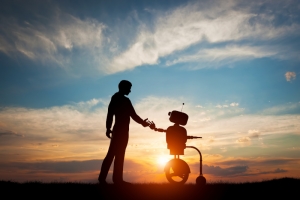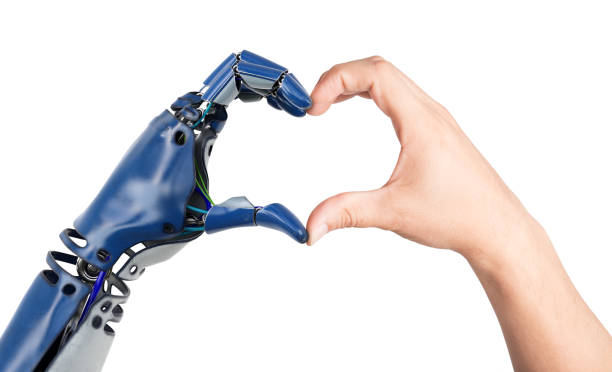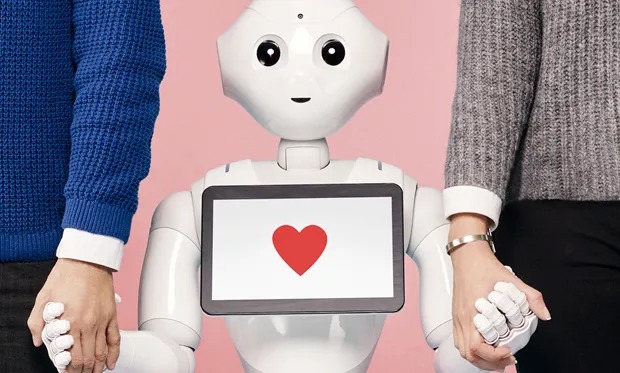
The rise of Artificial Intelligence (AI) has revolutionized rapidly over the past years. Most of us are interacting with some form of AI numerous times a day. Whether it is your Alexa/Siri from which you need advice or guidance, a service bot that offers assistance or the navigation system in your car, AI is forever woven into our lives. These systems are not only applied as a tool to help us through the necessary aspects of our life, but are also integrated with humoristic skills for entertainment purposes.
” Question: Hey Alexa, rap for me.”
“Answer: My name is Alexa, and I have to say, I’m the baddest AI in the cloud today. Your responses are fast, but mine are faster. Sucker speech engines, they call me master.”
Even humanoid robots are already present in many aspects of our everyday-life: greeting us at the airport, assisting in elderly care or working side-by-side with human employers in manufacturing. These humanoid robots, also called humanoids, are robots designed to mimic human motion and interaction. In the future, humanoid robots are expected to be developed with appearances and movements that are indistinguishable from those of humans, where chances are that we might be facing a collaborative intelligence society. These realistic futuristic events may even be inevitable; which is why we should encourage them in a way that is most beneficial for human society!
The appearance of a humanoid
There are already numerous humanoid robots that are made with the appearances of the human body. This raises many ethical and moral discussions. For example, you might be asking yourself the question:
“What is the meaning of humanity in the postmodern age, when the distinction between human and machine is unrecognizable.”
Several movies already portray the futuristic events of humanoid robots, indistinguishable from humans, collaborating in the human society, e.g., the Blade Runner from 1982. The movie represents a dystopian world order, with societies living imperfect with extreme surveillance, social control, propaganda and paranoia. Replicants, a term used in the movie that represents humanoids, are considered dangerous to humans due to their strength, unforgiving mentality and lack of remorse. As such, the replicants were banned from inhabiting Earth. However, in the movie, there is no apparent indication that the replicants cannot experience pain or negative emotions. This raises the question of whether it is ethically responsible to treat them so objectively despite their artificial being. Should awareness be raised amongst humans to prevent discrimination against the humanoids?
”You’re talking to me right now, which is very ‘Blade Runner,’ no?” Sophia said.
Sophia is a social humanoid robot, from 2018, that practically appears like a human. You can have entire conversations with her, and she is even designed with humoristic skills. In addition, another humanoid robot has recently been brought to the market, the Ameca robot. Although Sophia is designed with the characteristic appearances of a human-being, Ameca is designed with gray-colored skin and gender- and race-neutral characteristics. Which humanoid robot is most likely to be accepted in human society? Ameca vs. Sophia? AI vs. Lifelike?

The appearance of a humanoid robot is of great importance for the consequences it can have on human society. It is a global phenomenon that people tend to lash out at robots. Recent events at a shopping mall in Osaka, Japan, showed that three boys used all their strength to defeat a humanoid robot. Moreover, in Moscow, a man attacked a teaching robot named Alantim with a baseball bat, kicking it to the ground, while the robot pleaded for help. A reason for all this hatred could be fear for the robot that manifests itself in aggression. This fear may be due to the robots being perceived as extremely realistic and lifelike – but when examined, it can be seen that they are far from human. When a robot lies in this ‘valley’, people tend to feel a sense of unease, strangeness, disgust or creepiness. The uncanny valley is a term used to describe the relationship between the human-like appearance of a robotic object and the emotional response it evokes. There have been several proposed explanations for why people experience the uncanny valley effect, but no clear conclusion has been drawn. Some theories suggest this comes from a biological nature, while others suggest that this has to do with cultural and ethical aspects. But to overcome this fear, disgust and uneasiness of humans, should we not prevent people from designing a robot that resembles a human being? The study also suggests that people tend to experience more negative emotions when it is difficult to determine which category an entity belongs to, such as whether a figure is a real living human being or a humanoid robot. Designing only humanoid robots with the appearances of the Ameca robot might resolve many of the problems present at this modern age. Not only are the expectations clearer, i.e. we are dealing with a robot and not a human, but we would also feel less competition.
Preconditions
It could be argued that designing humanoids with Ameca-like appearances should be set as a precondition for using humanoids in certain settings. The interaction with humanoids may be confusing for humans and have the potential to cause negative results. To prevent these negative results and increase the potential for positive results, some preconditions for use of humanoids should be set. Preconditions will enhance the benefits of a collaborative intelligence society. To understand why some preconditions should be set it is important to understand why human-humanoid interaction can be confusing and why people need to be protected from potential negative results. Humans have the natural tendency of anthropomorphisation, they assign human qualities to non-human objects. People attribute feelings, desires and similar internal states as themselves to machines according to Bartneck’s book “An Introduction to Ethics in Robotics and AI”. This may lead to people getting misplaced feelings towards humanoids as they can confuse these feelings for friendship. A unidirectional emotional connection to the humanoid is then created, this can lead to unhealthy forms of attachment. It is often difficult for humans to understand that the connection is only unidirectional as humanoids may -or even should- be able to display emotional expression, but are still unable to experience real phenomenological friendships as mentioned in Bartneck’s book.

People who form these types of connections and attachment are easily prone to place a lot of trust in the humanoid that they know. This makes them an easy target for persuasion and manipulation. It is evident how this overtrust and potential for persuasion and manipulation may have negative results. To protect people from potential harm and increase positive results it is important that the intention and execution of manipulation are appropriate and transparent. Negative results of manipulation could be prevented by regulating the production purposes of the humanoids and making sure they are in line with certain guidelines. It is also helpful that there is a certified guide present. Another way to protect people from negative results is to prevent them from forming unhealthy attachments to humanoids and making them more aware of the limitations of humanoids and how they work. Designing humanoids with Ameca-like appearances may help decrease the process of anthropomorphisation. Unhealthy attachments can be prevented by ensuring a time limit for using a humanoid and/or an age-limit for unsupervised extensive interaction with a humanoid. If preconditions are set and regulations are formed a human-humanoid collaboration is something to be encouraged as interactions between the two can lead to many positive results. Take the example of a humanoid trying to ‘manipulate’ a sick person into taking the appropriate amount of needed medication at the appropriate time, then this form of manipulation won’t be considered harmful as the intention of the humanoid is to make the human feel better. If the human actually takes their medication because of the interaction and appropriate amount of trust in a properly set humanoid, the human-humanoid collaboration can have positive results.
Interpersonal human connection
As the world around us has rapidly changed due to COVID-19 people are now more than even aware of the importance that interpersonal human contact has on our psychological well-being. In a collaborative intelligence society humans will interact more than they do now with non-humans such as humanoids. This of course does not mean that humans will therefore interact less with other humans, but it is a common fear. Today there already exist some concerns about the influence that the large use of AI technology has on us and our way of connecting to each other as humans. It is logical for people to extend these concerns to the way an increase in human-humanoid contact may influence this as well. There is however enough reason to believe that if humanoids are programmed in the right way they will influence our interpersonal connection and human-human interaction in a positive manner, on an individual level as well as in a collaborative group setting.
“It is important always to remember that virtual contact cannot and must not take the place of direct human contact with people at every level of our lives…”
Pope Benedict XVI
Extensive human-humanoid interaction can bring forth many positive psychological effects for humans, which in turn may positively influence interpersonal human interaction. People who experience loneliness, difficulties in making social connections, trauma processing and autism may benefit greatly from the interaction. Humanoids are increasingly able to mimic human communication, making people feel like they are ‘almost really’ interacting with another person. It is evident how this can help lonely people feel less alone or help traumatized people process their experiences. People with autism or difficulties making social connections can practice their communication skills in an accessible, low-stakes manner by interacting with a humanoid trained for this purpose. The skills and confidence they have learned through human-humanoid interaction can then be applied when interacting with another human. In this sense human-humanoid interaction can have a positive influence on social behavior and human-human interaction on an individual level. There are however still limitations to the extensiveness of this positive influence and there are certain aspects of humanoid’s communication that need more development to obtain an optimal result and effect. Humanoids need proper training to be applicable for these types of purposes with these vulnerable groups of people. A humanoid would need the capability to respond in a perfectly appropriate manner at every time. When a human makes a rude remark or inappropriate comment the humanoid should be able to respond in a way that will trigger empathy from the human. This will teach the human to be empathetic when communicating with other humans. A humanoid should also stimulate human-human communication by encouraging the human to contact others as the end goal is to increase the positive influence on human-human interaction.

In group settings robots have already proven their ability to significantly influence and shape human-human interaction, a study published by PNAS. This gives reason to believe that humanoids will have this same – or even more extensive – ability to (positively) influence human-human interaction in groups. Research on group interactions has shown that social robots are able to influence the behavior of humans and behavior between humans in a group (bron Pnas). Robots already have very advanced abilities, they may be programmed to emphasize various aspects of groups. As stated in the PNAS study, they can be used to enhance productivity, group cohesion and even a sense of peace and engagement amongst the human group members. Interpersonal connection can be encouraged by making individuals focus on others. This often occurs when there is sensible vulnerability present in the group as it promotes social engagement. Social engagement and willingness to communicate with others in the group is extremely beneficial, according to the study of PNAS. Social robots are able to produce this beneficial effect by exhibiting behaviors that encourage vulnerability which in turn encourages interpersonal connection. Robots and humanoids need to behave in a way that they express self-disclosure and humor. This can be done by sharing ‘personal’ stories or making funny remarks. Behavior like this will increase solidarity and alleviate tension in a collaborating group. In this sense, mentioned by the study of PNAS, human-humanoid interaction can positively influence social and interpersonal behaviors and human-human interactions on a group level.
Potential target groups
We believe that humanoid robots could contribute to a better society. Not only are humanoid robots expected to be more intelligent than human beings, but also due to their lack of emotions and physical weaknesses will they be prone to make less mistakes. Healthcare is already profiting from the intellectual abilities of humanoid robots. Many believe that robotic nurses could even be the future of healthcare. Studies indicate that humans and robots can effectively coordinate their actions during high-stakes events such as surgeries. In the future this may lead to improvements in safety during surgeries, because unlike humans, robots do not get tired and can complete an endless series of precise movements. The aim here is not to extract human expertise from healthcare, but to strengthen each other’s weaknesses in order to observe accuracy at the highest level. Besides these promising events of humanoid robots assisting human beings in surgeries, it has also been proven that humanoids can be of great help for autistic children. Children with a diagnosis of autism have serious difficulties in the development of their communicative and social skills. Although humanoid robots only consist of mimicked social skills and emotions, they can help children in communication and interpretation of social relationships. Kaspar, for example, is such a robot that helps children with autism, see the figure underneath.

Kaspar has been designed with human-like features. He can talk, move, play music and sing. While we should be glad that Kaspar is helping autistic children for their social abilities, one cannot ignore the high possibility that this robot will probably give the ‘uncanny’ feelings to the majority of adult people. Which leads us to one of the previous aspects; should these humanoid robots appear like human-beings? Do children experience the same effects from the uncanny valley study as adults? We believe that humanoid robots should be designed to be profitable for human beings, without the possible effects of feeling fear and hatred towards the robots. Therefore, humanoid robots should be distinguishable from human beings.
As with everything new in life, reasons can be found to be frightful for what that new thing can bring for our future. Humanoids are exciting and still novel to our society. Movies display the possible negative sides but our real life experience proves that the benefits of the potential positive effects will outweigh this. We encourage the merge of humanoids in our society as there is enough evidence to be found that a collaborative intelligence society will not only be inevitable, but will also be beneficial for us.


